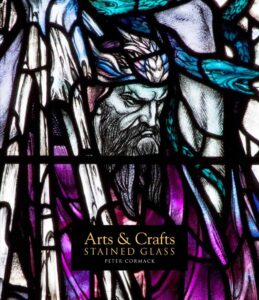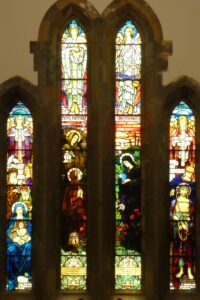Arts & Crafts Stained Glass
Peter Cormack
Yale University Press, 2015
This book was a real pleasure to read. It is full of information and loads of wonderful colour photographs.
Cormack is rather snooty about the predecessor of the Arts and Crafts movement. Gothic Revival stained glass that was the dominant stained glass windows style of the Victorian period. He implies that it was a production-line affair, where an artist would draw a design, taking only the styles from the mediaeval period. This was then passed to the stained glass company where one person would make the glass, another would cut it out, another would paint the simpler parts and their best artist would paint the faces.
Then along came the Arts and Crafts movement, led by Christopher Whall. Here, the artist would draw a picture, unrestrained by what had gone before, they would then personally lay out and select the glass, letting the glass itself influence the design, and limit the amount of painting required on top. The lead between the panes would be used to outline the figures, to again, limit the amount of painted lines.
My favourite window in the book is on page 132 of the Chancel window in New Kilpatrick church, Bearsden, Glasgow. It was made in 1910 by Stephen Adam and is said to include the hand of Alf Webster who had joined the studio at the time. The style is fairly traditional. It has wonderful colours, and packs the birth, death and resurrection of Jesus into the four narrow lights of the window (a ‘light’ refers to each part of window surrounded by masonry). On the left light is Mary, Jesus, the three kings, and an angel holding the guiding star. The right hand light, shows Jesus, bound and being led by a soldier towards his crucifixion. Above, is a weeping angel, holding a cross. In the centre two lights are the three women come to anoint Jesus’ body. Above them are two angels, one playing a harp, the other wafting incense, announcing ‘he is not here, he is risen’.
On our recent holiday to Scotland I visited the Church and was kindly shown this and the many other exceptional windows in the church. This is the photo I took:
When at the church, I bought a copy of the church history:
New Kilpatrick Parish and its Story
James McCardel, D.D.
Bell and Bain Ltd, Second Edition 1973.
Today we tend to think of the church today as suffering from divisions. This book reminds us that things were worse in the past as matters descended into violence or imprisonment:
“the Rev. Robert Law was inducted in 1651. When Charles II re-introduced episcopacy in 1661, Law was one of 300 ministers who refused to conform and so had to give place to a more accommodating person … [Law was] imprisoned for taking a service in Kilsyth” (page 45).
“Rev. William Duncan took up duty in 1666. As an episcopalian, his task was not easy … When Presbyterianism was restored in 1688, Duncan’s furniture was thrown out of the Manse and he himself had to flee for his life.” (page 45).
“The Rev. Andrew Gray was presented to the charge in 1731 by the patron, the Duke of Montrose, but some of the congregation wished to have Rev. John McCulloch as their minister … when Gray entered the church on his first Sunday, he found the pulpit filled with stones … he went into the precentor’s desk and managed to start the service … a riot took place in which the local Sheriff was wounded, some of the offenders were arrested and imprisoned… through the intercession of Gray, they were released… Gray’s appointment was confirmed.” (page 46).
Next we come to pastoral visiting.
We like to think in the previous generation, the vicar would regularly knock on the doors of all those living in the parish and be invited in for tea and scones. A nice chat would take place and the homeowner would offer ‘more tea vicar?’
Today, it is just as likely that if the vicar knocks on the door of a local, they may get it slammed in their face.
The power dynamics were very different even further in the past. The church representatives had the authority to tick-off any resident who didn’t attend church. The church had a group of elders, called the “Kirk Session”:
“The primary duty of the Session is to co-operate with the minister in the spiritual care of the church and the parish… As early as 1696, ‘the Session finding that many people lie scandalously at home on the Lord’s Day…and profane the day with their idle, vain and worldly discourses’, resolved to visit their quarters on the Lord’s Day, both to see ‘what real ground of necessity there is for their remaining at home’ and to encourage church attendance and godly living in the home and in the parish.” (pages 59-60).
Adrian Vincent. August 2021.

